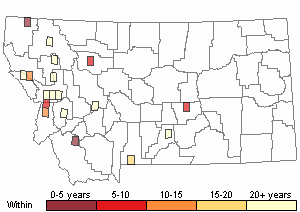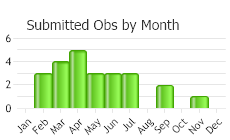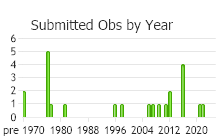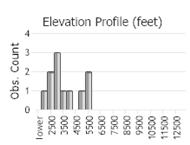View in other NatureServe Network Field Guides
NatureServe
Montana
Utah
Wyoming
Idaho
Wisconsin
British Columbia
South Carolina
Yukon
California
New York
A Pterynoneurum Moss - Pterygoneurum ovatum
Other Names:
Onion Moss
General Description
Plants: Dense brown tufts, 3-5 mm tall (Crum 1981). Central strand present in stems (FNA 2007).
Leaves: Oblong-ovate with blunt or broadly acute tips, concave. Margins a little incurved and erect when dry, spreading slightly when moist, length ca 1.5-2 mm (including awn). Awn almost as long as base, hyaline to pale-yellow, usually smooth but may have a few teeth (Crum 1981).
Leaf Cells: Upper cells squarish or short-rectangular, somewhat rounded, the walls strong with thickened corners, smooth (rarely weakly papillate in back). Basal cells rectangular with thinner walls. Lamellae 2-4 on adaxial side of costa, each ca 12 cells high (Crum 1981).
Phenology
Spores mature in spring (Crum 1981).
Range Comments
Canada: AB, BC, MB, NT, NU, ON, QC, SK, YT; USA: AK, AZ, CA, CO, ID, KS, MT, NT, NV, NM, ND, OR, SD, TX, UT, WA, WY; s South America; Europe; Asia; n Africa; Australia (FNA 2007). Crum (1981) adds that P. ovatum ranges widely in Europe, and has been reported from the Middle East, the Caucasus, and Kashmir. Known in Montana from Big Horn, Fallon, Flathead, Gallatin, Lake, Lewis and Clark, Missoula, Park, Ravalli, Sanders, and Stillwater Counties (Elliott 2016).
Observations in Montana Natural Heritage Program Database
Number of Observations: 24
(Click on the following maps and charts to see full sized version)
Map Help and Descriptions
Relative Density

Recency



 (Observations spanning multiple months or years are excluded from time charts)
(Observations spanning multiple months or years are excluded from time charts)
Habitat
Exposed, well-drained dry calcareous soil, low desert scrub, disturbed grassy areas (lawns, hayfields, roadsides), sometimes floodplains. Moderate elevations (3000-5200 feet) (Crum 1981; FNA 2007).
This species develops capsules in late winter, often while still covered with snow. Search for this species in places where the snow has just melted or is melting.
Reproductive Characteristics
Autoicous. Setae straight, 1.5-3.5 mm in length, brown. Capsules 1-1.5 mm in length, dark brown, wrinkled/pleated when dry, slightly exserted (Crum 1981).
Economic Value
P. ovatum aids in stabilizing arid soils (Flowers 1973).
Management
P. ovatum aids in stabilizing arid soils (Flowers 1973).
Stewardship Responsibility
References
- Literature Cited AboveLegend:
 View Online Publication
View Online Publication Crum, H.A. and L.E. Anderson. 1981. Mosses of Eastern North America. 2 volumes. Columbia University Press, New York. 1328 pp.
Crum, H.A. and L.E. Anderson. 1981. Mosses of Eastern North America. 2 volumes. Columbia University Press, New York. 1328 pp. Elliott, J.C. and A.K. Pipp. 2018. A Checklist of Montana Mosses (1880-2018). Updated 3 January, 2020. Montana Natural Heritage Program, Helena, Montana. 73 pp.
Elliott, J.C. and A.K. Pipp. 2018. A Checklist of Montana Mosses (1880-2018). Updated 3 January, 2020. Montana Natural Heritage Program, Helena, Montana. 73 pp. Flora of North America Editorial Committee, eds. 2007. Flora of North America North of Mexico. Volume 27. Bryophytes: Mosses, Part 1. Oxford University Press, Inc., NY. xxi + 713 pp.
Flora of North America Editorial Committee, eds. 2007. Flora of North America North of Mexico. Volume 27. Bryophytes: Mosses, Part 1. Oxford University Press, Inc., NY. xxi + 713 pp. Flowers, S. 1973. Mosses: Utah and the West. Brigham Young University, Provo, Utah. 567 p.
Flowers, S. 1973. Mosses: Utah and the West. Brigham Young University, Provo, Utah. 567 p.
- Additional ReferencesLegend:
 View Online Publication
View Online Publication
Do you know of a citation we're missing? Elliot, J. C. 1993. Second checklist of Montana mosses. Unpublished report. U.S. Forest Service, Region 1. Missoula, MT. 45 pp.
Elliot, J. C. 1993. Second checklist of Montana mosses. Unpublished report. U.S. Forest Service, Region 1. Missoula, MT. 45 pp. Lawton, E. 1971. Keys for the Identification of the Mosses on the Pacific Northwest. Reprinted from 'Moss Flora of the Pacific Northwest'. Published as Supplement No. 2 of the Journal of the Hattori Botanical Laboratory. Nichinan, Miyazaki, Japan. 66 pp.
Lawton, E. 1971. Keys for the Identification of the Mosses on the Pacific Northwest. Reprinted from 'Moss Flora of the Pacific Northwest'. Published as Supplement No. 2 of the Journal of the Hattori Botanical Laboratory. Nichinan, Miyazaki, Japan. 66 pp. Lawton, E. 1971. Moss Flora of the Pacific Northwest. Hattori Botanical Laboratory. Japan: Yamabuki-cho, Shinjuku-ku, Tokyo. 362 pages plus appendices.
Lawton, E. 1971. Moss Flora of the Pacific Northwest. Hattori Botanical Laboratory. Japan: Yamabuki-cho, Shinjuku-ku, Tokyo. 362 pages plus appendices.
- Web Search Engines for Articles on "A Pterynoneurum Moss"





